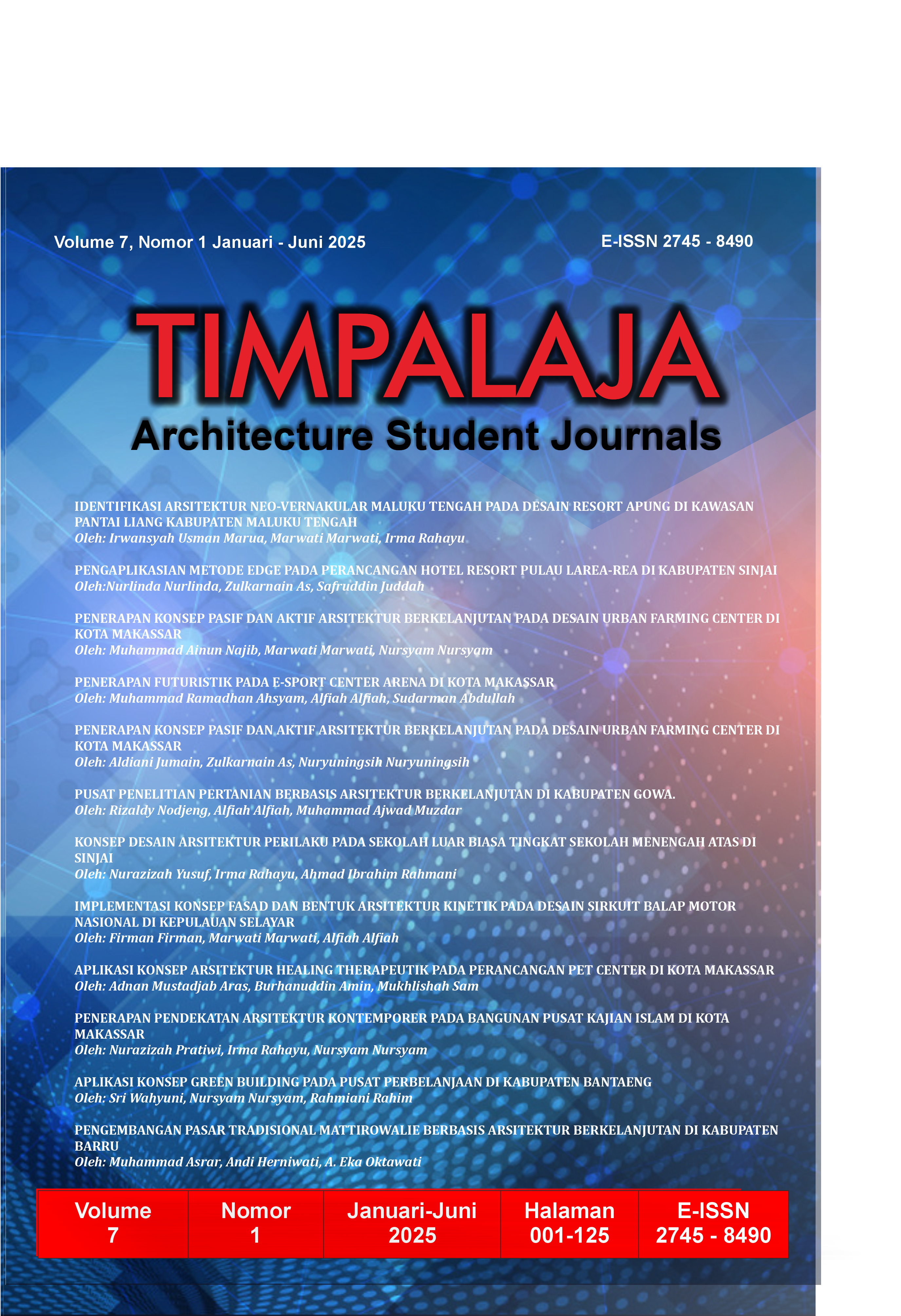Penerapan Pendekatan Arsitektur Kontemporer pada Bangunan Pusat Kajian Islam di Kota Makassar
DOI:
https://doi.org/10.24252/timpalaja.v7i1a10Keywords:
Contemporary Architecture, Makassar City, Center for Islamic StudiesAbstract
Contemporary architecture emerged as a response to changing times that demand innovation in architectural form and concept. This shift is driven by architects’ dissatisfaction with rigid conventional architectural theories. Dynamic design adaptations—such as the use of curved exterior lines, unique asymmetrical room shapes, aesthetically placed large windows, the application of neutral and bold colors, and unconventional materials like glass and metal—characterize contemporary architecture. Additionally, buildings often feature open roofs that apply environmentally friendly principles while providing protection from sunlight. To ensure that Islamic buildings remain relevant and modern in line with current developments, this study employed methods including literature review, analysis of contemporary design, and the application of aesthetic principles along with environmentally sustainable functions in the design process. The results demonstrate that the Islamic Studies Centre can achieve modern, aesthetic, and functional buildings through a contemporary architectural approach without compromising Islamic values while also supporting sustainability and user comfort.
References
Raidi, I. S. (2016). International Islamic Centre Di Surakarta Dengan Penekanan Pada Arsitektur Modern Kontemporer (Doctoral dissertation, Universitas Muhammadiyah Surakarta).
Chandra, W., Thahir, A. R., & Wijayanto, P. (2021). Implementation of contemporary architecture on the facade of the Islamic Centre building in Tulang Bawang Barat, Lampung. Jurnal Arsitektur dan Desain, 6–11.
Gazalba, S. (1994). Mesjid pusat ibadat dan kebudayaan Islam (Cetakan VI). Al Husna (Anggota IKAPI). https://etheses.uinsgd.ac.id/10680/4/4_BAB%20I.pdf
Hidayatullah, R. (2017). Laporan seminar desain arsitektur bab II tinjauan pustaka - evaluasi penerapan karakteristik arsitektur kontemporer (studi kasus desain masjid Ontowiryo di Purworejo, Jawa Tengah) (hal. 6–25).
Mahdy, M. (2022). Museum mobil Ford klasik di kota Jakarta [Skripsi]. Universitas Katolik Soegijapranata Semarang. http://repository.unika.ac.id/id/eprint/29675
Nugroho, S., Cahyadi, E., Egziabher, T. B. G., & Edwards, S. (2017). Detail tentang arsitektur kontemporer. Africa’s Potential for the Ecological Intensification of Agriculture, 53(9), 1689–1699. http://e-journal.uajy.ac.id/11419/
Nurlatifah, W. (2018). Arsitektur dan aktivitas Masjid Al Baakhirah (Lautan) di Kota Cimahi tahun 2015-2016 [Diploma thesis]. UIN Sunan Gunung Djati Bandung. https://etheses.uinsgd.ac.id/id/eprint/10680
Prayoga, E. G. (2019). Pendekatan arsitektur tradisional pada bangunan pendidikan berkonsep modern “Karol Wojtyla” Universitas Katolik Atma Jaya. Jurnal Arsitektur Purwarupa, 3(3), 193–198.
Priambudi, I. A. (2022). Perencanaan dan perancangan MICE (Meeting, Incentive, Convention, Exhibition) dengan pendekatan arsitektur kontemporer (La Font Convention Center, Cibubur) [Skripsi]. Universitas Mercu Buana Bekasi. https://repository.mercubuana.ac.id/id/eprint/72056
Wijaya, T. (2019). Pusat studi arsitektur di Surakarta: Pendekatan pada konsep arsitektur kontemporer [Laporan].
Sugiyono. (2011). Metode penelitian kuantitatif, kualitatif, dan R&D. Bandung: Alfabeta
Downloads
Published
How to Cite
Issue
Section
License
Copyright (c) 2025 Nurazizah Pratiwi, Irma Rahayu, Nursyam Nursyam

This work is licensed under a Creative Commons Attribution-ShareAlike 4.0 International License.
By submitting your manuscript to our journal, you are following Copyright and License



















